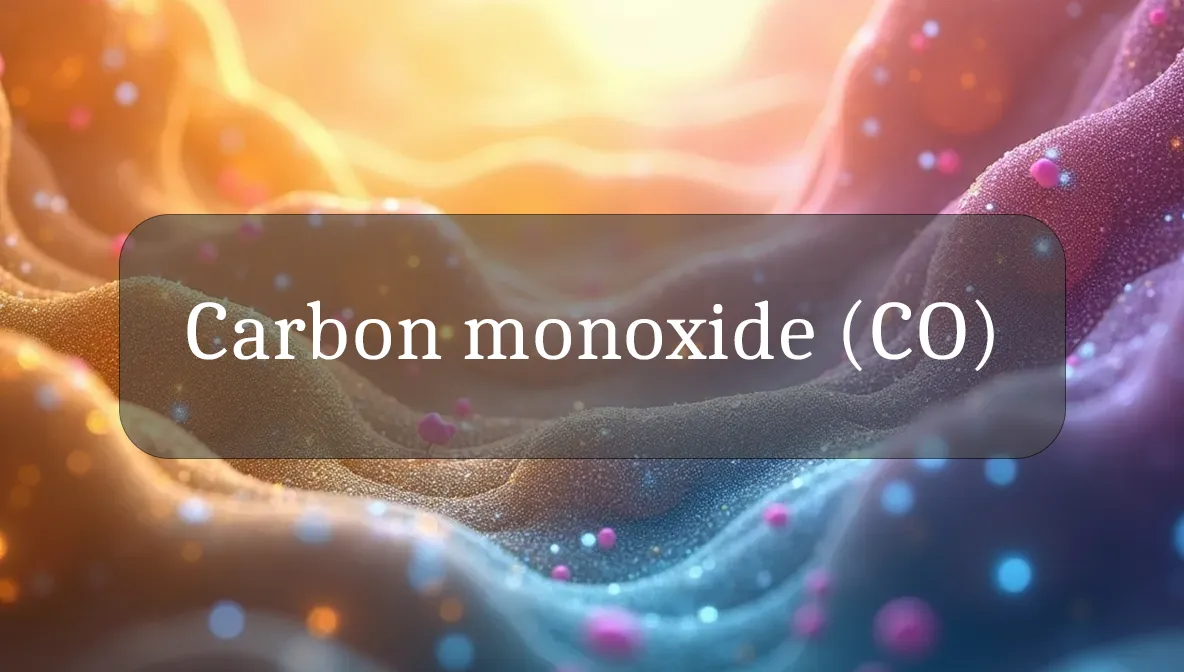Silent Gas with a Dual Role in Health
Carbon monoxide (CO) is like a double-edged sword in your body—a gas that’s dangerous in high amounts but, in tiny doses, acts as a subtle helper for your cells and blood vessels. It’s not a nutrient you seek out, but understanding its role can empower your wellness by focusing on safety and supporting your body’s natural balance. Let’s explore what CO is, its limited biological benefits, and practical ways to stay safe—all in a clear, friendly way to guide your health journey.
Chemical Identity and Type
Carbon monoxide (CO) is a small gas molecule composed of one carbon and one oxygen atom. It’s a gasotransmitter in the body, meaning it acts as a body signal in tiny amounts to regulate cellular processes. CO is produced naturally in your body during the breakdown of heme (a component of red blood cells) by the enzyme heme oxygenase. However, CO is primarily known as a toxic gas from external sources like car exhaust or faulty heaters, binding tightly to hemoglobin and reducing oxygen delivery.
Biological Role and Benefits
In small, controlled amounts, CO has subtle benefits in your body, but it’s not essential for wellness. Here’s how it supports you:
- Blood Vessel Health: CO relaxes blood vessels, improving blood flow and supporting healthy blood pressure in tiny doses.
- Inflammation Control: It calms excessive inflammation, aiding recovery from stress or injury at low levels.
- Cell Protection: CO acts as a mild cell protector, reducing damage from harmful molecules (free radicals) in specific contexts.
- Neurological Support: In trace amounts, it may protect brain cells, supporting resilience against stress.
These benefits occur naturally from your body’s own CO production. External CO exposure offers no health benefits and is highly dangerous, as it starves cells of oxygen.
Dietary or Natural Sources
Your body makes small amounts of CO during heme breakdown, so it’s not consumed through food. No dietary sources directly provide CO, and it’s not a nutrient. To support your body’s natural CO-related processes (e.g., heme oxygenase activity), focus on:
- Iron-Rich Foods: Beef, spinach, and lentils (support heme production in red blood cells).
- Antioxidant Foods: Berries, dark chocolate, and leafy greens (enhance cell protection, complementing CO’s minor role).
- Nutrient Boosters: Vitamin C (oranges, peppers), zinc (oysters, seeds), and B vitamins (eggs, whole grains) support red blood cell health.
- Protein-Rich Foods: Chicken, fish, or beans (provide amino acids for enzyme function).
No CO supplements exist, as it’s a gas and toxic in higher amounts. Antioxidant supplements (e.g., vitamin C, 500–1,000 mg daily) may support related cellular health. Aim for 0.8–1.2 grams of protein per kilogram of body weight daily (e.g., 56–84 grams for a 150-pound person).
Signs of Imbalance or Dysfunction
CO “imbalance” typically means excessive exposure from external sources, as natural production is tightly regulated. Signs of issues include:
- Excess CO (Poisoning):
- Headache, dizziness, or confusion.
- Nausea, weakness, or fatigue.
- Shortness of breath or chest pain.
- Loss of consciousness or seizures in severe cases.
- Low CO (Rare, Not Typically Problematic):
- No clear symptoms, as the body’s small CO production is not critical for survival.
- Possible subtle inflammation or vascular issues in extreme enzyme deficiencies (very rare).
Excess CO comes from environmental exposure (e.g., car fumes, smoking, faulty appliances), not diet or lifestyle. Low CO production is rarely a health concern.
Supporting Optimal Levels or Function
Since CO’s beneficial role is minimal and managed by your body, the focus is on preventing toxic exposure and supporting related systems:
- Avoid CO Exposure: Install CO detectors in your home, avoid running cars in garages, and ensure heaters or stoves are well-ventilated.
- Support Cellular Health: Eat antioxidant-rich foods (berries, spinach) and iron sources (beef, kale) to support red blood cell and enzyme function.
- Stay Active: Moderate exercise like walking or yoga (3–5 times weekly) boosts circulation and cellular health, complementing CO’s minor vascular role.
- Get Enough Sleep: Aim for 7–9 hours to support overall cellular repair and balance.
- Stay Hydrated: Drink 8–10 cups of water daily to aid detoxification and circulation.
- Avoid Smoking: Tobacco smoke contains CO, increasing toxicity risk and harming blood vessels.
- Boost Nutrients: Include vitamin C (citrus, peppers) and zinc (nuts, oysters) to enhance cell protection and enzyme activity.
No supplements are needed to boost CO, as excess is harmful.
Safety, Interactions, and Precautions
CO is safe in the tiny amounts your body produces but highly dangerous in excess. Consider these points:
- Toxicity Risk: Inhaling CO from car exhaust, heaters, or smoke can cause poisoning, reducing oxygen in your blood and risking brain or heart damage. Seek immediate medical help if symptoms like dizziness or confusion appear.
- Medical Conditions: Heart or lung diseases increase vulnerability to CO poisoning; take extra precautions with ventilation.
- Environmental Safety: Regularly check CO sources (e.g., gas appliances) and avoid enclosed spaces with combustion.
- Medications/Supplements: No direct interactions with CO, but antioxidants like vitamin C are safe and support related cellular health.
- Chronic Exposure: Low-level CO exposure (e.g., from smoking) can harm blood vessels over time; prioritize clean air.
Focus on preventing CO exposure rather than seeking its minimal benefits.
Fun Fact
Did you know your body makes CO every time it recycles old red blood cells? It’s like a tiny cleanup crew turning waste into a signal that keeps your blood vessels relaxed!
Citations
- National Institutes of Health. (2023). Carbon monoxide and health effects. MedlinePlus.
- Mayo Clinic. (2024). Carbon monoxide poisoning prevention.
- Cleveland Clinic. (2022). The role of carbon monoxide as a gasotransmitter.
- World Health Organization. (2020). Environmental health and air quality.
- National Center for Biotechnology Information. (2023). Heme oxygenase and CO signaling.

